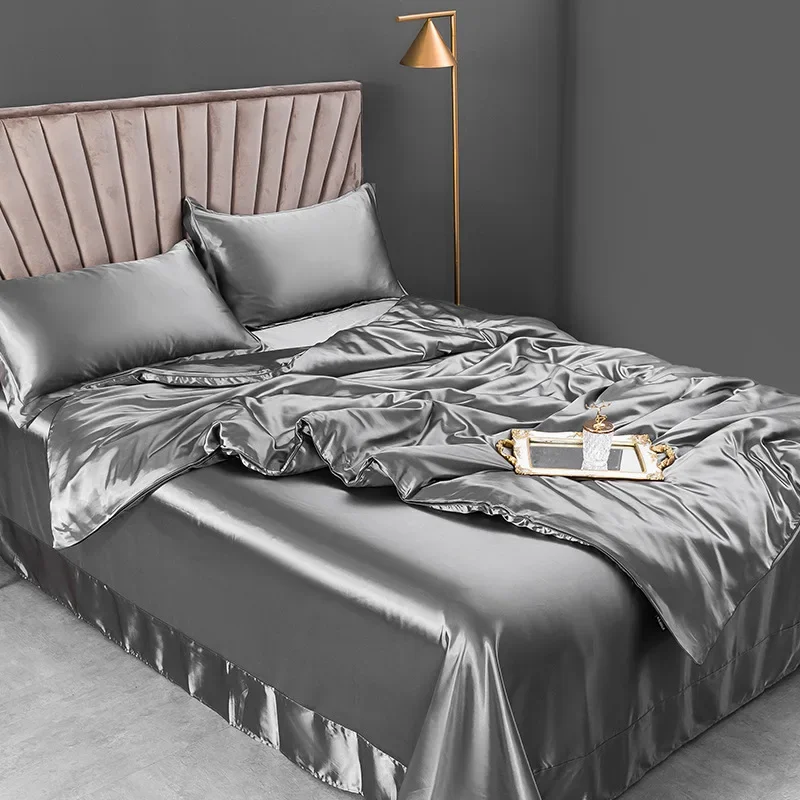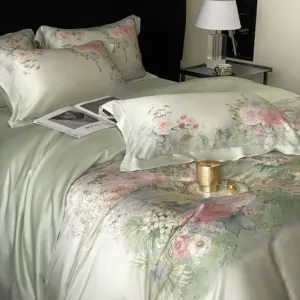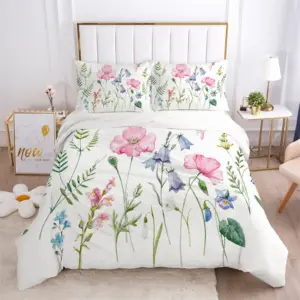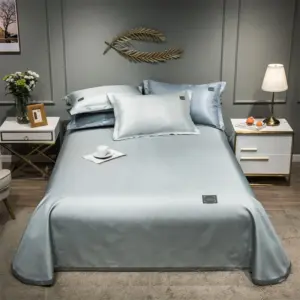Embracing Sustainable Sleep: The Rise of Eco-Friendly Silk
In recent years, our bedrooms have become the new frontier for eco-conscious living. As we spend roughly a third of our lives sleeping, more people are recognizing that the fabrics touching our skin night after night matter—not just for comfort, but for our planet’s wellbeing too.
Silk has captivated humans for thousands of years with its incomparable softness and lustrous sheen. This ancient luxury fabric, once reserved for royalty, continues to symbolize the pinnacle of bedding comfort. However, modern consumers now seek more than just indulgence—they want sustainability alongside that legendary Mulberry silk experience.
The sustainable home textile market has grown by over 20% in the last five years, reflecting a powerful shift in consumer priorities. This surge comes partly in response to growing awareness about conventional silk production, which often involves intensive water use, chemical treatments, and ethical concerns regarding silkworm cultivation.
Today’s conscious sleepers are discovering they don’t need to choose between luxury and environmental responsibility. The world of eco-friendly silk bedding offers options that satisfy both desires—whether through responsibly-produced genuine silk or innovative plant-based alternatives that mimic silk’s beloved properties while treading more lightly on our planet.
This guide explores genuine eco-friendly silk options and sustainable alternatives, helping you create a sleep sanctuary that aligns with both your comfort standards and environmental values.
What Makes Silk Truly Eco-Friendly?
Before diving into specific products, it’s essential to understand what qualifies silk as environmentally responsible. Not all silk is created equal when it comes to sustainability, and knowing the differences helps make informed purchasing decisions.
Conventional vs. Eco-Friendly Silk Production
Traditional silk production, while creating a beautiful natural fiber, often comes with significant environmental costs. Conventional methods typically involve:
- Heavy pesticide use on mulberry trees (silkworm food source)
- Chemical-intensive processing to remove sericin (the natural gum binding silk fibers)
- Harsh synthetic dyes containing heavy metals and toxins
- Excessive water consumption throughout production
- Energy-intensive manufacturing processes
In contrast, eco-friendly silk embraces a different approach focused on minimizing environmental impact while maintaining silk’s luxurious properties. The advantages of sleeping on quality silk remain, but with a much lighter footprint.
Key Criteria for Environmentally Responsible Silk
For silk to be truly eco-friendly, several important factors must be considered:
Organic Cultivation Methods
Genuine eco-friendly silk begins with organically grown mulberry trees, cultivated without synthetic pesticides or fertilizers. This preserves soil health and protects local ecosystems and waterways from chemical runoff.
Reduced Chemical Processing
Sustainable silk production minimizes harsh chemical treatments during fiber processing. Traditional degumming and bleaching processes are replaced with gentler, often enzyme-based alternatives that break down sericin naturally.
Water Conservation Techniques
Eco-conscious silk producers implement closed-loop water systems, water recycling protocols, and treatment processes that prevent pollution from entering local waterways—addressing one of conventional silk’s largest environmental impacts.
Ethical Harvesting Practices
How silkworms are treated represents a significant ethical and sustainability consideration. Conventional silk production typically involves boiling silk cocoons with the silkworms still inside, while more sustainable approaches may include peace silk methods (allowing moths to emerge naturally) or focusing on less harmful harvesting techniques.
Choosing bedding from our Mulberry silk bedding sets collection ensures you’re getting products that meet rigorous environmental standards while providing the sensory pleasures silk is famous for.
Organic Mulberry Silk: The Gold Standard
When discussing eco-friendly silk options, organic Mulberry silk represents the pinnacle of sustainable luxury. This premium material combines silk’s legendary properties with environmentally responsible production methods.
What Makes Mulberry Silk “Organic”?
Organic Mulberry silk comes from silkworms that feed exclusively on leaves from organically cultivated mulberry trees. This cultivation occurs without:
- Synthetic pesticides or insecticides
- Chemical fertilizers
- Genetically modified organisms
- Growth regulators or other artificial inputs
The result is a purer form of silk that contains no harmful chemical residues while supporting healthier ecosystems throughout the production process.
The Eco-Friendly Production Process
Sustainable Mulberry silk production focuses on minimizing environmental impact at every stage:
- Natural or low-impact dyes replace conventional synthetic options
- Reduced water usage through efficient processing methods
- Energy-efficient manufacturing techniques
- Minimal chemical treatments during processing
- Ethical labor practices throughout the supply chain
These practices significantly reduce pollution, water consumption, and carbon emissions compared to conventional silk production.
Benefits of Organic Mulberry Silk
Choosing organic Mulberry silk bedding provides numerous advantages:
- Superior softness and comfort that improves with proper care
- Natural temperature regulation for year-round comfort
- Hypoallergenic properties ideal for sensitive skin
- Moisture-wicking capabilities that keep skin hydrated
- Exceptional durability when proper momme weight (fabric density) is selected
- Peace of mind knowing your luxury comes with minimal environmental impact
Understanding the complete guide to Mulberry silk bed sheets helps appreciate why this material has remained coveted for thousands of years. When produced responsibly, Mulberry silk represents a truly sustainable luxury.
Quality organic Mulberry silk typically ranges from 19-25 momme weight, with higher numbers indicating greater silk density and durability. This weight range offers the optimal balance between luxurious drape and long-lasting performance.
Browse our collection of premium Mulberry silk sheets to experience the perfect combination of indulgence and environmental responsibility.
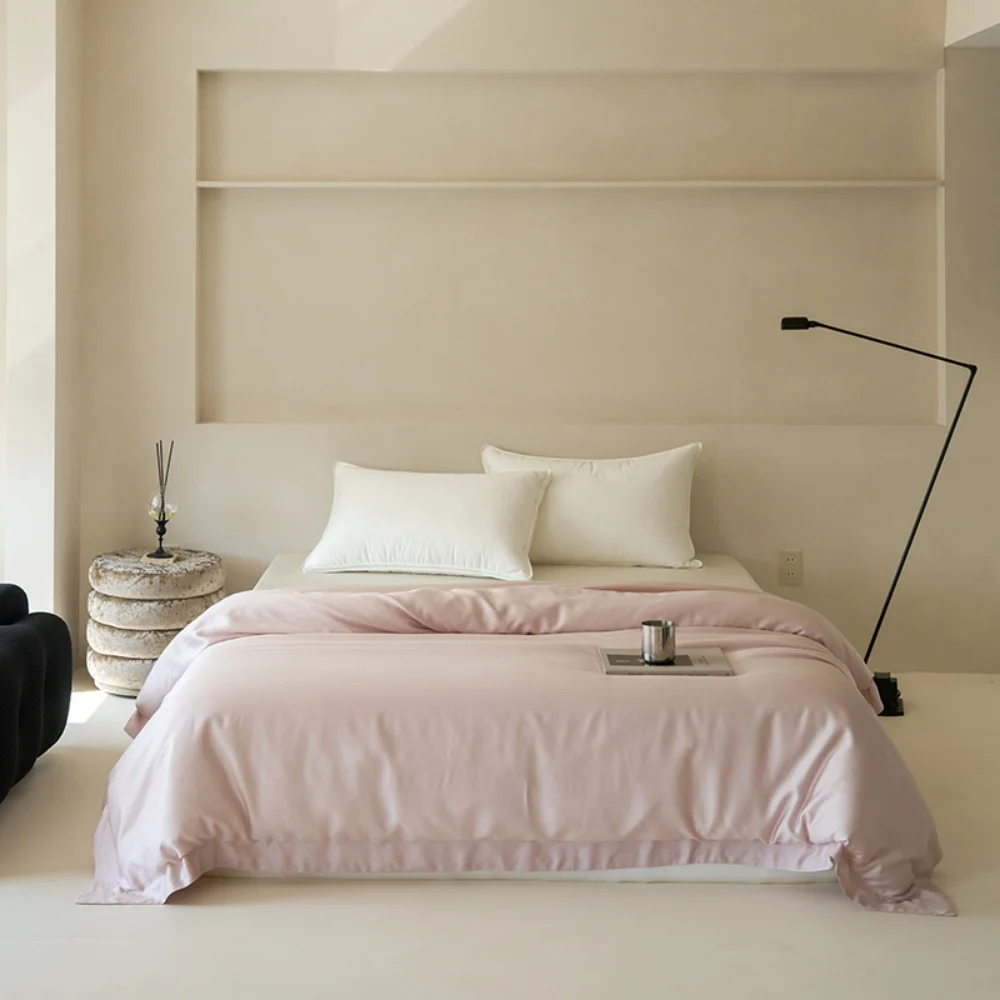
Peace Silk (Ahimsa Silk): The Ethical Alternative
For those seeking the ultimate in ethical silk production, peace silk—also called ahimsa silk—represents a compassionate alternative that addresses both environmental and ethical concerns.
A Gentler Approach to Silk Production
Traditional silk harvesting involves boiling silk cocoons while the silkworm pupae remain inside, killing the developing moths before they can emerge and damage the continuous silk filaments. Peace silk takes a fundamentally different approach:
- Silkworms complete their natural lifecycle, allowing moths to emerge from cocoons
- Cocoons are collected only after the moths have naturally emerged
- The resulting broken silk filaments are hand-spun into yarn
- This process requires more silk cocoons and labor for the same amount of fabric
The result is a truly cruelty-free silk that aligns with values of compassion while maintaining most of silk’s desirable properties.
Unique Characteristics of Peace Silk
Peace silk has distinct differences from conventional silk:
- Slightly more textured appearance with less uniform sheen
- Wonderfully soft but with a somewhat different hand-feel
- Natural color variations that showcase its artisanal nature
- Comparable breathability and temperature regulation
- Similar hypoallergenic properties to conventional silk
While many wonder are Mulberry silk sheets good for their needs, peace silk offers an alternative that prioritizes ethical concerns without significant compromise on quality.
Environmental Benefits
Beyond its ethical advantages, peace silk production often incorporates additional eco-friendly practices:
- Typically involves smaller-scale, traditional production methods
- Generally uses fewer chemicals throughout processing
- Often employs natural dyeing techniques
- Supports artisanal communities and traditional craftsmanship
This approach creates a silk product with a unique character and compelling story—luxury bedding that nurtures both personal comfort and ethical values.
Beyond Silk: Sustainable Plant-Based Alternatives
While eco-friendly silk options offer significant improvements over conventional silk production, some consumers seek entirely plant-based alternatives for environmental, ethical, or personal reasons. The good news is that remarkable innovations in textile technology have created vegan options that rival silk’s legendary properties.
These plant-derived alternatives deliver similar sensory experiences to genuine silk—softness, smooth drape, temperature regulation—while often providing additional sustainability benefits. Many come from rapidly renewable resources with smaller environmental footprints than even the most responsibly produced animal silk.
The rise of these vegan silk alternatives reflects growing consumer demand for products that align with both luxury expectations and environmental values. Each plant-based option offers a unique combination of properties, making them suitable for different preferences and needs.
Understanding the traditional silk vs. vegan silk comparison helps consumers make informed choices based on their priorities, whether environmental impact, ethical concerns, performance characteristics, or maintenance requirements.
Let’s explore these innovative alternatives in detail to discover which might best suit your sustainable sleep sanctuary.
TENCEL™ Lyocell (Eucalyptus Silk): The Modern Marvel
TENCEL™ Lyocell, often marketed as “eucalyptus silk,” stands as one of the most impressive sustainable alternatives to traditional silk. This innovative fabric offers remarkable environmental credentials alongside performance characteristics that closely mimic genuine silk.
Sustainable Source and Revolutionary Production
TENCEL™ Lyocell is derived from eucalyptus wood pulp harvested from certified sustainable forests. These fast-growing trees:
- Require minimal water and no irrigation
- Need no pesticides or fertilizers
- Grow on marginal land unsuitable for food crops
- Can be harvested from certified sustainable plantations
What truly distinguishes TENCEL™ is its award-winning closed-loop production system. This innovative process:
- Recycles 99.5% of water and solvents used in manufacturing
- Uses non-toxic, biodegradable solvents to transform wood pulp into fiber
- Creates virtually zero waste discharge
- Consumes significantly less energy than conventional textile production
Properties and Performance
TENCEL™ Lyocell offers performance characteristics remarkably similar to silk:
- Exceptional softness that rivals or exceeds silk’s smooth feel
- Natural sheen reminiscent of silk’s lustrous appearance
- Superior breathability allowing excellent airflow
- Outstanding moisture management (absorbs 50% more moisture than cotton)
- Natural temperature regulation for year-round comfort
- Resistance to bacterial growth for improved hygiene
These properties make our eucalyptus silk sheets an excellent choice for those seeking silk-like luxury with enhanced environmental benefits. The material drapes beautifully, feels cool against the skin, and provides similar sensory pleasure to high-quality silk.
Environmental Advantages
TENCEL™ Lyocell represents a significant environmental improvement even over organic silk:
- Uses 10-20 times less water than conventional cotton
- Biodegrades completely at end of life
- Requires less land area for raw material production
- Results in substantially lower carbon footprint
- Avoids ethical concerns related to silkworm cultivation
This combination of luxury performance and environmental responsibility makes TENCEL™ Lyocell one of the most compelling sustainable bedding options available today.
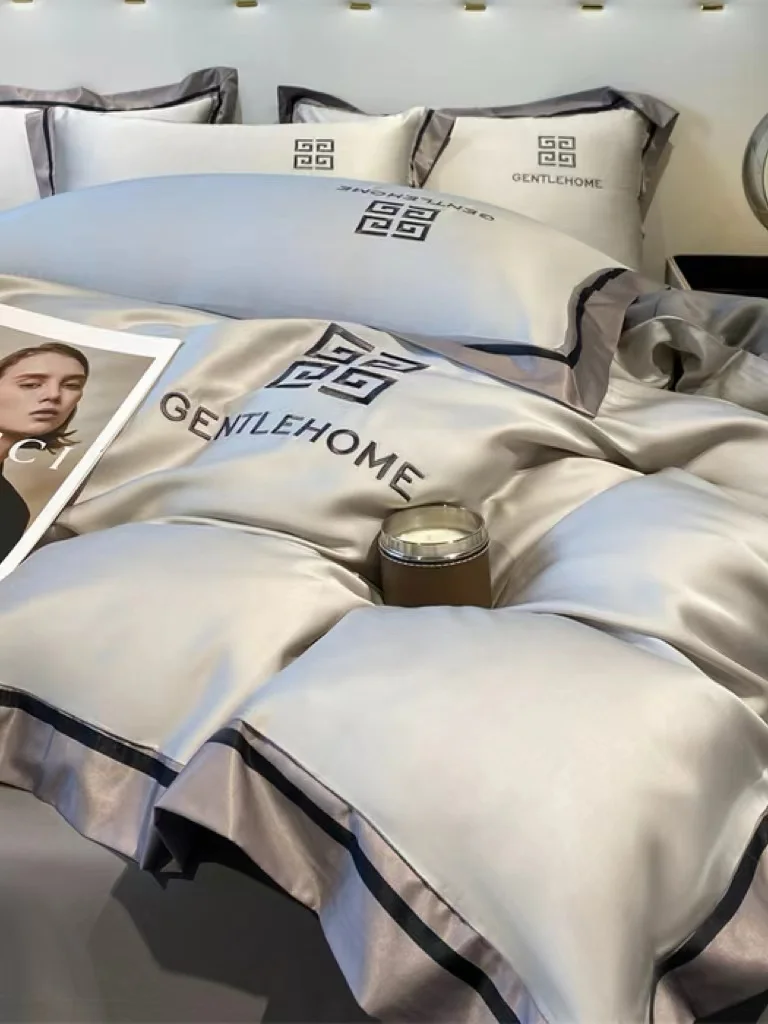
Bamboo Lyocell: Sustainable Softness
Another exceptional silk alternative comes from one of nature’s most remarkable plants: bamboo. When processed using the lyocell method (similar to TENCEL™), bamboo becomes a luxurious fabric with impressive eco-credentials and performance characteristics.
Bamboo’s Sustainability Powerhouse
Bamboo’s natural growth characteristics make it an environmental superstar:
- World’s fastest growing plant, with some species growing 3 feet in 24 hours
- Requires no irrigation, pesticides, or fertilizers
- Produces 35% more oxygen than equivalent stands of trees
- Prevents soil erosion with extensive root systems
- Regenerates from its own roots without replanting
These qualities make bamboo an incredibly renewable resource. However, the environmental benefits only translate to the final fabric when using sustainable processing methods.
Bamboo Lyocell vs. Bamboo Viscose
It’s crucial to distinguish between bamboo lyocell and the more common bamboo viscose (sometimes marketed as “bamboo rayon”):
Bamboo Lyocell uses the same closed-loop system as TENCEL™, with non-toxic solvents recycled at rates exceeding 99%. This minimizes environmental impact and creates a truly sustainable fabric.
Bamboo Viscose employs a chemical-intensive process using caustic soda and carbon disulfide, creating significant pollution concerns. Many “bamboo” sheets on the market use this less sustainable method.
Our bamboo silk sheets utilize the environmentally responsible lyocell process to create truly sustainable bedding.
Silk-Like Properties
Bamboo lyocell offers remarkable similarities to silk:
- Exceptional softness that rivals high-quality silk
- Silky smooth texture with beautiful drape
- Natural temperature regulation (cooler than cotton in summer, warmer in winter)
- Excellent moisture-wicking properties
- Antibacterial and antifungal properties that reduce odors
- Hypoallergenic benefits for sensitive sleepers
These characteristics make bamboo lyocell bedding an excellent choice for those seeking silk’s comfort benefits with enhanced sustainability and easier maintenance.
Organic Cotton Sateen: The Classic Reimagined
While innovative materials like TENCEL™ and bamboo lyocell offer exciting silk alternatives, organic cotton sateen provides a more familiar option with impressive eco-credentials and silk-like properties.
The Organic Difference
Organic cotton represents a significant environmental improvement over conventional cotton:
- Cultivated without synthetic pesticides or fertilizers
- Prohibits use of genetically modified organisms
- Employs crop rotation to maintain soil health
- Uses 71% less water and 62% less energy than conventional cotton
- Reduces farmer exposure to harmful chemicals
The Global Organic Textile Standard (GOTS) certification ensures these practices are followed throughout the production chain, making it the gold standard for genuinely sustainable cotton products.
Sateen: The Silk-Like Weave
What transforms organic cotton into a silk alternative is the sateen weave structure:
- Uses long-staple cotton fibers for smoother yarn
- Features a “four over, one under” weaving pattern (compared to the “one over, one under” of standard cotton)
- Creates a smooth surface with fewer exposed fiber ends
- Produces a subtle sheen reminiscent of silk
- Results in a drapey, fluid fabric that feels luxurious against skin
While cotton sateen lacks the protein structure of silk that provides some of its beneficial properties, the combination of organic cultivation and sateen weaving creates a luxurious, sustainable bedding option.
How It Compares to Silk
Organic cotton sateen offers several advantages and differences compared to silk:
- More affordable than high-quality silk
- Easier maintenance (machine washable)
- Slightly less temperature regulation but still breathable
- Heavier weight and different drape than silk
- Durable and becomes softer with washing
- Lacks silk’s natural protein benefits for skin and hair
For those with sensitive skin concerns, organic cotton sateen provides a gentle, chemical-free option that delivers much of the tactile pleasure of silk without animal-derived materials.
Linen and Hemp: Ancient Fibers for Modern Eco-Bedding
Some of our most sustainable textile options come from ancient plants that humans have cultivated for thousands of years. Linen (derived from flax) and hemp represent two traditional fibers experiencing a renaissance in eco-friendly bedding.
Environmental Excellence
Both linen and hemp boast impressive sustainability credentials:
Linen (Flax)
– Grows with minimal water (typically relies on rainfall alone)
– Requires few or no pesticides or fertilizers
– Uses virtually all parts of the plant (zero waste)
– Flax cultivation improves soil health
– Carbon negative when grown without artificial inputs
Hemp
– Grows quickly (ready for harvest in 90-120 days)
– Requires minimal water and no pesticides
– Produces more fiber per acre than cotton
– Naturally suppresses weeds, eliminating herbicide need
– Phytoremediates soil (removes toxins)
These characteristics make both fibers exceptionally sustainable choices for environmentally conscious consumers.
Distinct Textural Experience
Unlike other silk alternatives that aim to mimic silk’s smooth feel, linen and hemp offer a different but equally appealing tactile experience:
- Natural textural character with subtle irregularities
- Exceptional coolness to the touch
- A relaxed, lived-in aesthetic that improves with age
- Distinctive matte appearance versus silk’s lustrous sheen
- Structured drape rather than fluid flow
Those choosing Mulberry silk sheets often seek a smooth, lustrous feel, while linen and hemp appeal to those preferring a more textural, natural aesthetic.
Performance Characteristics
These ancient fibers offer performance benefits that may surprise those unfamiliar with their properties:
- Extraordinary durability (linen can last for decades)
- Natural antibacterial properties
- Superior moisture-wicking abilities
- Excellent temperature regulation
- Become softer and more comfortable with each washing
- Hypoallergenic properties ideal for sensitive skin
While providing a different sensory experience than silk, these materials offer compelling alternatives for those seeking maximum sustainability with distinctive natural character.

Decoding Eco-Certifications: Your Trustworthiness Guide
With numerous brands claiming “eco-friendly” status, third-party certifications provide crucial verification of environmental and ethical practices. Understanding these certifications helps you make genuinely sustainable choices rather than falling victim to greenwashing.
Global Organic Textile Standard (GOTS)
The most comprehensive certification for organic textiles:
– Covers entire supply chain from harvesting to labeling
– Prohibits toxic heavy metals, formaldehyde, GMOs
– Requires wastewater treatment at processing facilities
– Mandates minimum social criteria (fair wages, no child labor)
– Products must contain at least 70% organic fibers (95% for “organic” label)
Look for the GOTS logo with license number for verification.
OEKO-TEX Standard 100
Focuses specifically on harmful substances in textiles:
– Tests for over 100 harmful substances
– Considers legal regulations and harmful chemicals not yet regulated
– Applies stricter limits than national regulations
– Four product classes with varying requirements (Class I for baby products is strictest)
– Annual re-certification required
This certification ensures the final product is free from harmful substances that could affect human health.
Forest Stewardship Council (FSC)
Essential for wood-derived fabrics like TENCEL™ and bamboo:
– Ensures responsible forest management
– Protects biodiversity and old-growth forests
– Prevents illegal logging
– Respects indigenous peoples’ rights
– Chain-of-custody tracking from forest to consumer
FSC certification is particularly important for eucalyptus and bamboo products to verify sustainable sourcing.
Cradle to Cradle Certified™
Evaluates products based on circular economy principles:
– Assesses material health (safe ingredients)
– Material reuse potential
– Renewable energy usage
– Water stewardship
– Social fairness
This holistic certification examines sustainability across the entire product lifecycle.
Fair Trade Certified
Focuses on the human element of production:
– Ensures fair wages for workers
– Prohibits forced and child labor
– Provides safe working conditions
– Supports community development
– Promotes environmental sustainability
Understanding ethical and sustainable luxurious vegan fabrics requires attention to both environmental and social certification standards. When evaluating product claims, look beyond marketing language to verify these trusted third-party certifications.
5 Key Benefits of Choosing Eco-Friendly Bedding
Selecting sustainable bedding offers advantages that extend far beyond environmental impact. Here are five compelling benefits that make eco-friendly options worth the investment:
1. Environmental Responsibility
Eco-friendly bedding significantly reduces your environmental footprint:
– Conserves water (conventional textile production is water-intensive)
– Reduces chemical pollution in waterways and soil
– Decreases carbon emissions through sustainable production methods
– Supports biodiversity by avoiding harmful agricultural practices
– Promotes responsible resource management
Every sustainable bedding purchase contributes to preserving our planet for future generations.
2. Health & Well-being
The materials touching your skin for 7-9 hours each night impact your health:
– Absence of harmful chemicals reduces skin irritation and respiratory issues
– Hypoallergenic properties benefit allergy sufferers
– No off-gassing of volatile organic compounds (VOCs)
– Natural breathability reduces night sweats and improves sleep quality
– Moisture management keeps skin healthy and prevents bacterial growth
The exceptional benefits of Mulberry silk sheets for skin and hair are well-documented, and eco-friendly alternatives offer similar advantages without synthetic chemicals.
3. Superior Comfort & Performance
Sustainable materials often outperform conventional options in key comfort metrics:
– Enhanced temperature regulation for year-round comfort
– Superior moisture-wicking properties keep you dry
– Natural fibers provide better breathability
– Luxurious softness improves with proper care
– Distinctive tactile properties enhance sleep experience
These performance benefits explain why many luxury hotels and spas choose sustainable bedding options.
4. Durability & Longevity
Quality eco-friendly bedding represents an investment that pays dividends over time:
– Superior fiber strength means fewer replacements
– Natural fibers often become softer and more comfortable with age
– Proper care extends lifespan significantly
– Reduces waste through longer useful life
– Lower lifetime cost despite higher initial investment
When cared for properly, premium eco-friendly bedding can last for many years, making it economically sensible as well as environmentally responsible.
5. Ethical Impact
Your bedding choices influence production practices worldwide:
– Supports fair labor practices and living wages
– Encourages sustainable farming techniques
– Rewards companies prioritizing environmental responsibility
– Drives innovation in sustainable textile development
– Creates market demand for responsible production
Choosing eco-friendly options helps transform sleep quality while supporting positive change in the textile industry.
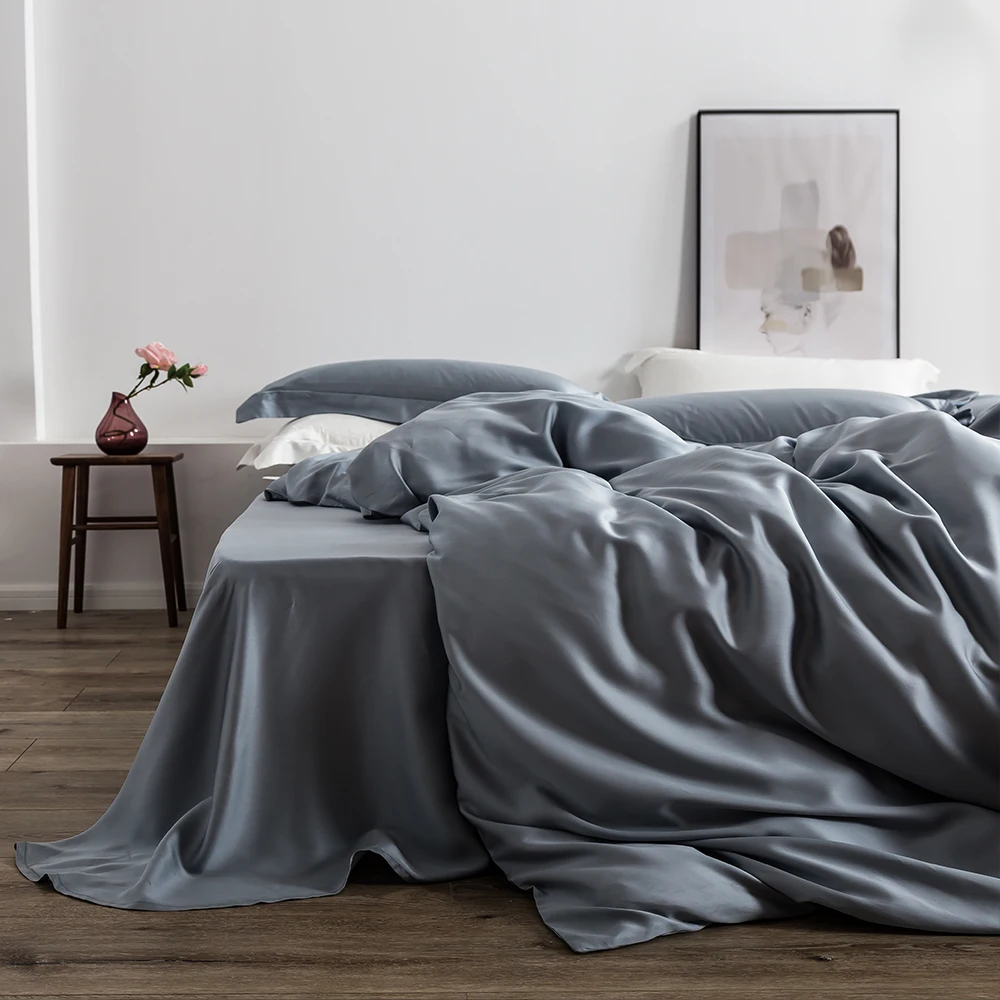
How to Select Your Perfect Eco-Friendly Bedding
With so many sustainable options available, finding your ideal bedding requires considering several factors. This systematic approach will help you identify the perfect eco-friendly bedding for your specific needs:
Assess Your Sleep Environment & Preferences
Start by evaluating your sleep situation:
– Climate considerations: Hot sleepers or warm climates benefit from excellent temperature regulation (TENCEL™, bamboo lyocell)
– Skin sensitivity: Those with allergies or sensitive skin should prioritize hypoallergenic options (organic Mulberry silk, organic cotton)
– Maintenance willingness: Consider how much care you’re willing to provide (silk requires more careful handling)
– Aesthetic preferences: Determine if you prefer lustrous sheen (silk, TENCEL™) or more textural character (linen, hemp)
– Ethical priorities: Decide if animal-derived materials are acceptable or if you require vegan options
Evaluate Material Quality Indicators
For each material type, specific quality markers help identify premium products:
For Silk:
– Momme weight (19-25 momme for optimal balance of luxury and durability)
– Type of silk (Mulberry silk is superior to other varieties)
– Certification standards (GOTS, OEKO-TEX)
For Plant-Based Alternatives:
– Processing method (lyocell process is more eco-friendly than viscose)
– Fiber length (longer fibers create smoother fabrics)
– Weave type (sateen weaves create more silk-like finishes)
– Relevant certifications (FSC for wood-derived fibers, GOTS for cotton)
Consider Brand Transparency
Look for companies that openly share:
– Specific information about material sourcing
– Details about manufacturing processes
– Clear certification documentation
– Commitment to ongoing sustainability improvements
Our luxury silk bedding sets come with transparent information about sourcing, production, and certification to help you make informed choices.
Balance Price vs. Long-Term Value
When evaluating cost:
– Consider cost-per-use over the product’s lifetime
– Factor in durability and replacement frequency
– Remember that proper care extends product life
– Weigh enhanced sleep quality and health benefits in your calculation
– Look for versatile options that work year-round
Understanding the skin benefits of Mulberry silk bedding and similar advantages from eco-alternatives helps justify the investment in premium sustainable bedding.
Our Top Eco-Friendly Silk Bedding Recommendations
At Sanctuary Soft, we take pride in offering genuinely sustainable silk bedding options that meet rigorous environmental and quality standards:
Premium Organic Mulberry Silk Collection
Our signature silk collection features:
– 19-25 momme weight range for optimal luxury and durability
– OEKO-TEX certification ensuring freedom from harmful substances
– Naturally hypoallergenic properties ideal for sensitive skin
– Temperature-regulating properties for year-round comfort
– Rich, vibrant colors achieved through low-impact dyeing processes
Each product undergoes comprehensive testing for:
– Tensile strength and durability
– Color consistency and fastness
– Tactile quality assessment
– Breathability and moisture management
Available in multiple colors and sizes, our silk bedding sets include everything from individual sheets to complete sheet and pillowcase sets for a coordinated sleep sanctuary.
Our organic Mulberry silk collection represents the pinnacle of sustainable luxury—environmentally responsible without compromising the exquisite feel and benefits that make silk an eternal favorite.
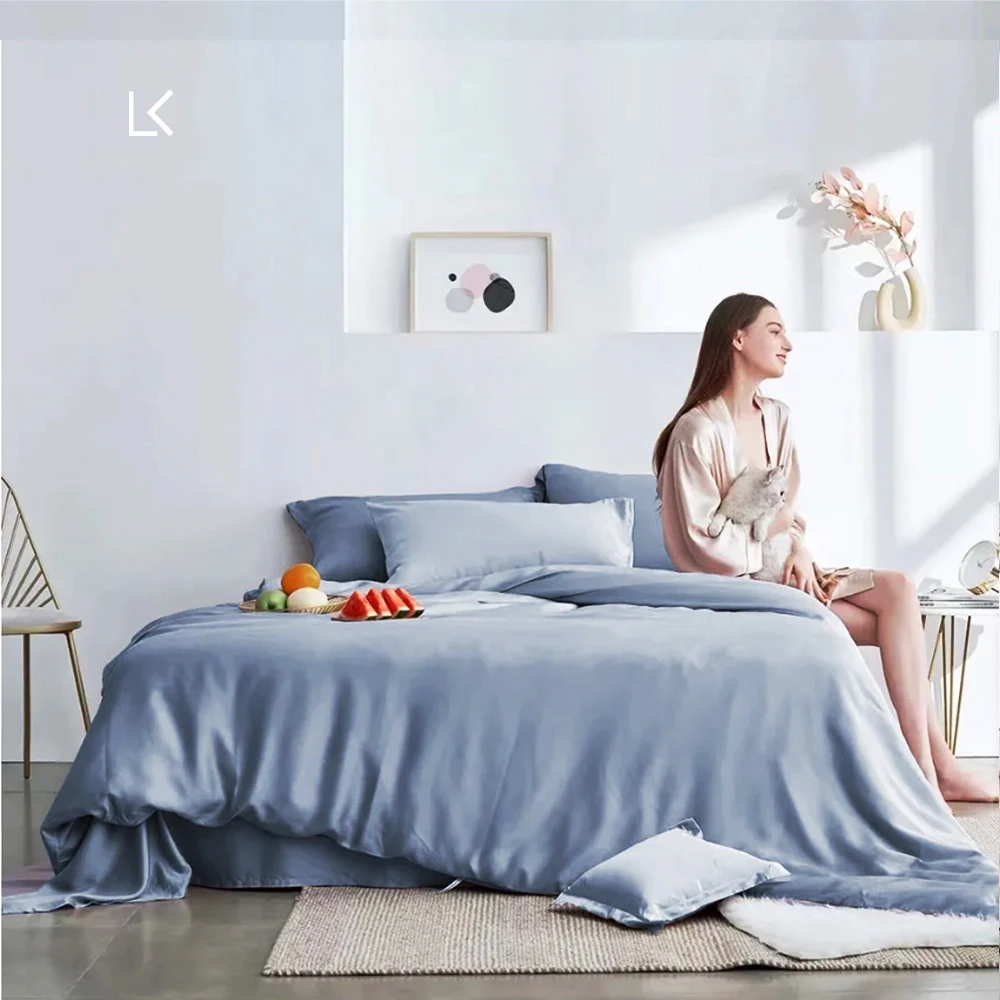
Premium Eco-Friendly Silk Alternatives We Recommend
For those seeking plant-based alternatives to silk, Sanctuary Soft offers several exceptional options that deliver silk-like luxury with enhanced sustainability:
TENCEL™ Lyocell Collection
Our eucalyptus-derived bedding features:
– Silky-smooth texture that rivals genuine silk
– Superior moisture management for dry, comfortable sleep
– FSC-certified sustainable eucalyptus sources
– Closed-loop production process with minimal environmental impact
– Natural cooling properties ideal for hot sleepers
The eucalyptus silk bedding sets provide an excellent vegan alternative with performance characteristics remarkably similar to premium silk.
Bamboo Lyocell Selection
Our bamboo collection offers:
– Exceptional softness with a silky feel
– Natural temperature regulation for year-round comfort
– Sustainable bamboo sourcing with rapid renewability
– Hypoallergenic properties beneficial for sensitive skin
– Outstanding moisture-wicking capabilities
These bamboo silk bedding sets deliver luxurious comfort with impressive environmental credentials.
Organic Cotton Sateen Options
For those preferring a more familiar fabric with silk-like properties:
– GOTS-certified organic cotton ensuring environmental responsibility
– Sateen weave creating smooth, lustrous finish
– Excellent breathability and natural comfort
– Easy care and exceptional durability
– Chemical-free production for healthier sleep
Our cooling silk sheets collection includes options in all these materials, helping you find the perfect balance of luxury, sustainability, and temperature regulation.
100% Silk Sheets, Green Silk Sheets, King Size Silk Bedding Set, Mulberry Silk Bedding Sets, Queen Size Silk Bedding Set
Price range: $1,246.21 through $1,615.22 Select options This product has multiple variants. The options may be chosen on the product pageEucalyptus Silk Bedding Sets, Eucalyptus Silk Sheets
Price range: $360.24 through $393.60 Select options This product has multiple variants. The options may be chosen on the product pageFull Silk Bedding Set, King Size Silk Bedding Set
Price range: $120.99 through $190.49 Select options This product has multiple variants. The options may be chosen on the product pageGrey Silk Sheets, Silk Sheet and Pillowcase Set
Price range: $88.20 through $146.64 Select options This product has multiple variants. The options may be chosen on the product page- Price range: $267.82 through $306.55 Select options This product has multiple variants. The options may be chosen on the product page
Bamboo Silk Sheets, Cooling Silk Sheets
Price range: $130.76 through $177.80 Select options This product has multiple variants. The options may be chosen on the product page
Care Guide: Maximizing the Life of Your Eco-Bedding
Proper care significantly extends the lifespan of sustainable bedding, enhancing both environmental benefits and your investment value. Different materials require specific approaches:
Caring for Genuine Silk
To maintain silk’s luxurious properties:
– Hand wash with pH-neutral silk detergent in cold water
– Alternatively, use washing machine’s delicate cycle in a mesh laundry bag
– Never use bleach, enzymes, or brightening agents
– Air dry away from direct sunlight (hanging or flat)
– Iron on lowest setting only if necessary (while slightly damp)
– Store in breathable cotton bags, not plastic
Understanding silk momme weight helps determine appropriate care—higher momme weights are slightly more durable but still require gentle handling.
Caring for TENCEL™ and Bamboo Lyocell
These plant-based alternatives are easier to maintain:
– Machine wash in cold water on gentle cycle
– Use mild, eco-friendly detergent free from harsh chemicals
– Avoid fabric softeners (they coat fibers and reduce natural benefits)
– Tumble dry on low or air dry for maximum longevity
– Remove promptly from dryer to prevent wrinkles
– Iron on low setting if needed
Caring for Organic Cotton Sateen
For longest life from cotton bedding:
– Wash in cold or warm water (not hot)
– Use plant-based detergents free from brighteners
– Avoid bleach, which damages fibers and shortens lifespan
– Tumble dry on medium or line dry
– Remove promptly to minimize wrinkling
– Iron on cotton setting if desired for crisp appearance
Caring for Linen and Hemp
These durable fibers benefit from specific care:
– Machine wash in cold water on gentle cycle
– Use mild detergent without bleach or brighteners
– Tumble dry on low or air dry (they become softer with each wash)
– Remove while slightly damp to reduce wrinkling
– Embrace the natural texture—excessive ironing isn’t necessary
Proper care not only extends product lifespan but also maintains the performance properties that make eco-friendly bedding so exceptional.
Common Questions About Eco-Friendly Silk Bedding
Is any silk truly vegan?
No, genuine silk always comes from silkworms and therefore isn’t vegan. Even peace silk (ahimsa silk), which allows moths to emerge naturally, uses cocoons from silkworms. However, plant-based alternatives like TENCEL™ Lyocell, bamboo lyocell, and organic cotton sateen provide vegan options with similar properties to silk.
How do silk alternatives compare in feel to real silk?
Each alternative has distinct characteristics:
– TENCEL™ Lyocell offers remarkable similarity to silk in smoothness and drape, with superior cooling properties
– Bamboo lyocell provides comparable softness with slightly more weight and excellent moisture management
– Organic cotton sateen delivers a smooth feel with more substantial weight and less sheen
– Linen and hemp offer a different but equally luxurious textural experience
Many people find eucalyptus silk bedding sets provide the closest match to genuine silk’s feel while offering enhanced sustainability.
Are eco-friendly bedding options more expensive?
Initially, yes—quality eco-friendly bedding typically costs more upfront than conventional alternatives. However, considering longer lifespan, reduced replacement frequency, and enhanced sleep quality, they often represent better long-term value. Additionally, some alternatives like TENCEL™ and bamboo lyocell cost less than premium silk while providing similar benefits.
Can I machine wash all eco-friendly silk alternatives?
Yes, most plant-based silk alternatives are machine washable, making them more convenient than genuine silk. TENCEL™, bamboo lyocell, organic cotton sateen, linen, and hemp can all be washed in machines using gentle cycles and mild detergents. Only genuine silk requires special care considerations.
What’s the best eco-friendly option for hot sleepers?
TENCEL™ Lyocell (eucalyptus silk) provides exceptional cooling properties through superior moisture management and breathability, making it ideal for hot sleepers. Bamboo lyocell offers similar benefits. Linen also excels at temperature regulation in warm conditions. For those who prefer genuine silk, lightweight options (19 momme) provide better breathability than heavier weights.
Why Choose Sanctuary Soft for Your Eco-Bedding Journey?
At Sanctuary Soft, our commitment to sustainable luxury drives everything we do. We believe exceptional sleep shouldn’t come at the planet’s expense, which is why we’ve developed bedding collections that satisfy both environmental values and comfort expectations.
Our dedication to quality manifests through:
- Rigorous material selection: We source only premium fibers that meet strict sustainability criteria
- Comprehensive testing: Every product undergoes testing for strength, color consistency, and tactile quality
- Ethical manufacturing: We partner with facilities committed to fair labor practices and environmental responsibility
- Transparent practices: We openly share our sourcing, production methods, and certification standards
- Ongoing innovation: We continually explore new sustainable materials and production techniques
By focusing on both environmental impact and exceptional sleep experience, we create bedding that transforms ordinary rest into extraordinary rejuvenation. Our balance of luxury and responsibility means you never need to compromise—you can enjoy the ultimate in comfort while supporting planetary health.
Creating Your Sustainable Sleep Sanctuary
The bedding choices we make extend far beyond personal comfort—they reflect our values and impact our world. By selecting eco-friendly silk or sustainable alternatives, you create a sleep environment that nurtures both your wellbeing and our planet’s health.
Whether you choose the legendary luxury of organic Mulberry silk, the ethical consideration of peace silk, or the innovative sustainability of plant-based alternatives, your decision supports more responsible textile production. Each purchase becomes a vote for cleaner manufacturing, reduced chemical use, and more mindful resource management.
The benefits of this choice are both immediate and far-reaching. You’ll experience enhanced comfort, potential skin and hair improvements, and the satisfaction of aligning your purchases with your values. Meanwhile, your support encourages continued innovation in sustainable textiles, benefiting communities and ecosystems worldwide.
Creating your sustainable sleep sanctuary isn’t just about beautiful bedding—it’s about embracing a more conscious approach to life’s everyday luxuries. It’s about recognizing that the most indulgent experiences can also be the most responsible ones.
We invite you to transform your bedroom into a haven of sustainable luxury—where exceptional comfort and environmental mindfulness coexist beautifully, night after night.

